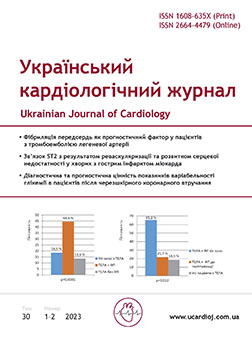Changes in the normal blood pressure profile under various stress conditions in patients with arterial hypertension
Main Article Content
Abstract
The aim – to assess the influence of various external factors and stress due to a large-scale military invasion on the daily blood pressure (BP) profile.
Materials and methods. This was a retrospective analysis of examined patients who underwent ABPM in the last 5 years. We conditionally divided the observation period into several time intervals: the «War» – 1st group, the «Before the war» – 2nd group, the «Covid» – 3rd group, and the «Peace» – 4th group, in each of it 20 patients were selected by the method of random numbers. All patients underwent ABPM using the Watch BP 03 device (Microlife AG, Switzerland).
Results. All groups were comparable according to the age, gender, and average daily BP and heart rate parameters of participants. Patients of all groups were middle-aged, the amount of men and women was equal in all groups, groups were comparable according to the results of average daily systolic (SBP), diastolic (DBP), pulse (PBP) BP and heart rate. We found that the 1st group had a significantly lower percentage of SBP and DBP decrease at night compared to all other groups (7.6±1.3% for SBP and 10.2±1.4% for DBP). The standard deviation of SBP and DBP was significantly higher in the 2nd group (19.8±1.1 and 14.2±0.7, respectively) compared to the 1st group (16.0±0.9 and 11.7±0.6, respectively) and 3rd (16.2±0.7 and 11.8±0.7, respectively). The highest frequency of non-dippers for SBP and DBP was observed in the 1st group (60 and 45 % respectively).
Conclusions. During the war, the reduction of SBP and DBP at night in patients with hypertension was significantly lower than in the period before the war, pandemic Covid-19, and peace pre-war. There was also a higher number of non-dippers in this group.
Article Details
Keywords:
References
Boos CJ, Toon LT, Almahdi H. The relationship between ambulatory arterial stiffness, inflammation, blood pressure dipping and cardiovascular outcomes. BMC Cardiovasc Disord. 2021;21(1):139. doi: https://doi.org/10.1186/s12872-021-01946-2.
Kammila S, Campbell NR, Brant R, deJong R, Culleton B; University of Calgary Clinical Hypertension Research Group. Systematic error in the determination of nocturnal blood pressure dipping status by ambulatory blood pressure monitoring. Blood Press Monit. 2002;7(2):131-4. doi: https://doi.org/10.1097/00126097-200204000-00007.
Kario K. Morning surge in blood pressure and cardiovascular risk: evidence and perspectives. Hypertension. 2010;56(5):765-73. doi: https://doi.org/10.1161/HYPERTENSIONAHA.110.157149.
Krakoff LR. Ambulatory blood pressure improves prediction of cardiovascular risk: implications for better antihypertensive management. Curr Atheroscler Rep. 2013;15(4):317. doi: https://doi.org/10.1007/s11883-013-0317-9.
Lip S, Mccallum L, Delles C, McClure JD, Guzik T, Berry C, Touyz R, Padmanabhan S. Rationale and Design for the LOnger-term effects of SARS-CoV-2 INfection on blood Vessels And blood pRessure (LOCHINVAR): an observational phenotyping study. Open Heart. 2022;9(1):e002057. doi: https://doi.org/10.1136/openhrt-2022-002057.
Parati G, Stergiou GS, Dolan E, Bilo G. Blood pressure variability: clinical relevance and application. J Clin Hypertens (Greenwich). 2018;20(7):1133-7. doi: https://doi.org/10.1111/jch.13304.
Stevens SL, Wood S, Koshiaris C, Law K, Glasziou P, Stevens RJ, McManus RJ. Blood pressure variability and cardiovascular disease: systematic review and meta-analysis. BMJ. 2016;354:i4098. doi: https://doi.org/10.1136/bmj.i4098.
Strawn JR, Ekhator NN, Horn PS, Baker DG, Geracioti TD Jr. Blood pressure and cerebrospinal fluid norepinephrine in combat-related posttraumatic stress disorder. Psychosom Med. 2004;66(5):757-9. doi: https://doi.org/10.1097/01.psy.0000138133.72365.45.
Williams B, Mancia G, Spiering W, Agabiti Rosei E, Azizi M, Burnier M, Clement DL, Coca A, de Simone G, Dominiczak A, Kahan T, Mahfoud F, Redon J, Ruilope L, Zanchetti A, Kerins M, Kjeldsen SE, Kreutz R, Laurent S, Lip GYH, McManus R, Narkiewicz K, Ruschitzka F, Schmieder RE, Shlyakhto E, Tsioufis C, Aboyans V, Desormais I; ESC Scientific Document Group. 2018 ESC/ESH Guidelines for the management of arterial hypertension. Eur Heart J. 2018;39(33):3021-104. doi: https://doi.org/10.1093/eurheartj/ehy339. Erratum in: Eur Heart J. 2019 Feb 1;40(5):475.
Zanutto BS, Frías BC, Valentinuzzi ME. Blood pressure long term regulation: a neural network model of the set point development. Biomed Eng Online. 2011;10:54. doi: https://doi.org/10.1186/1475-925X-10-54.

